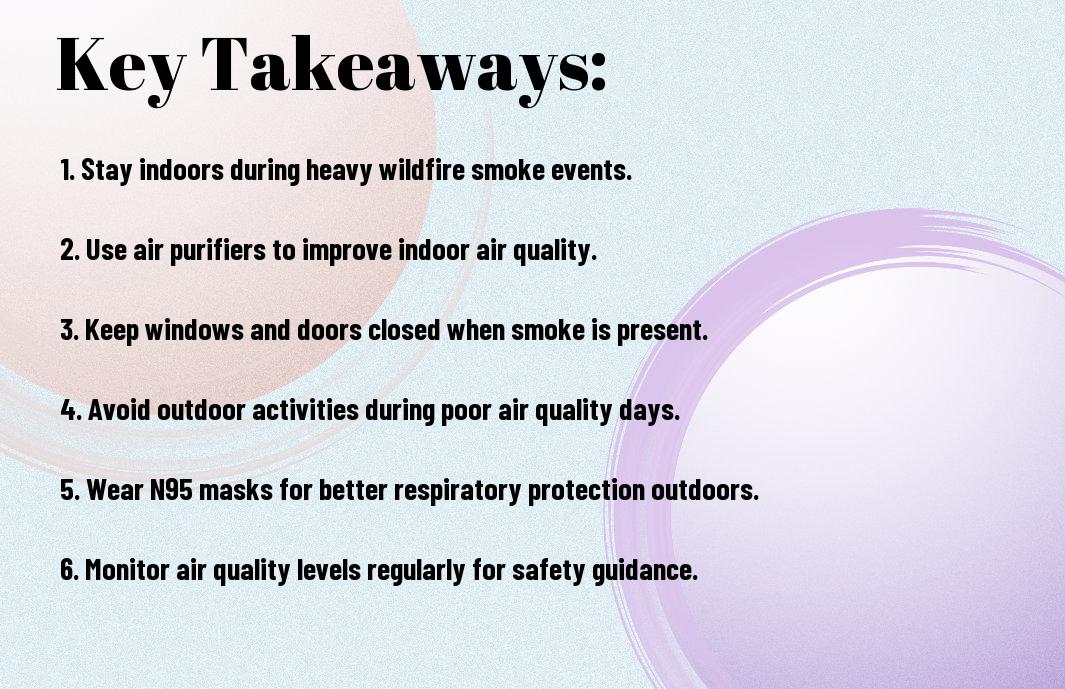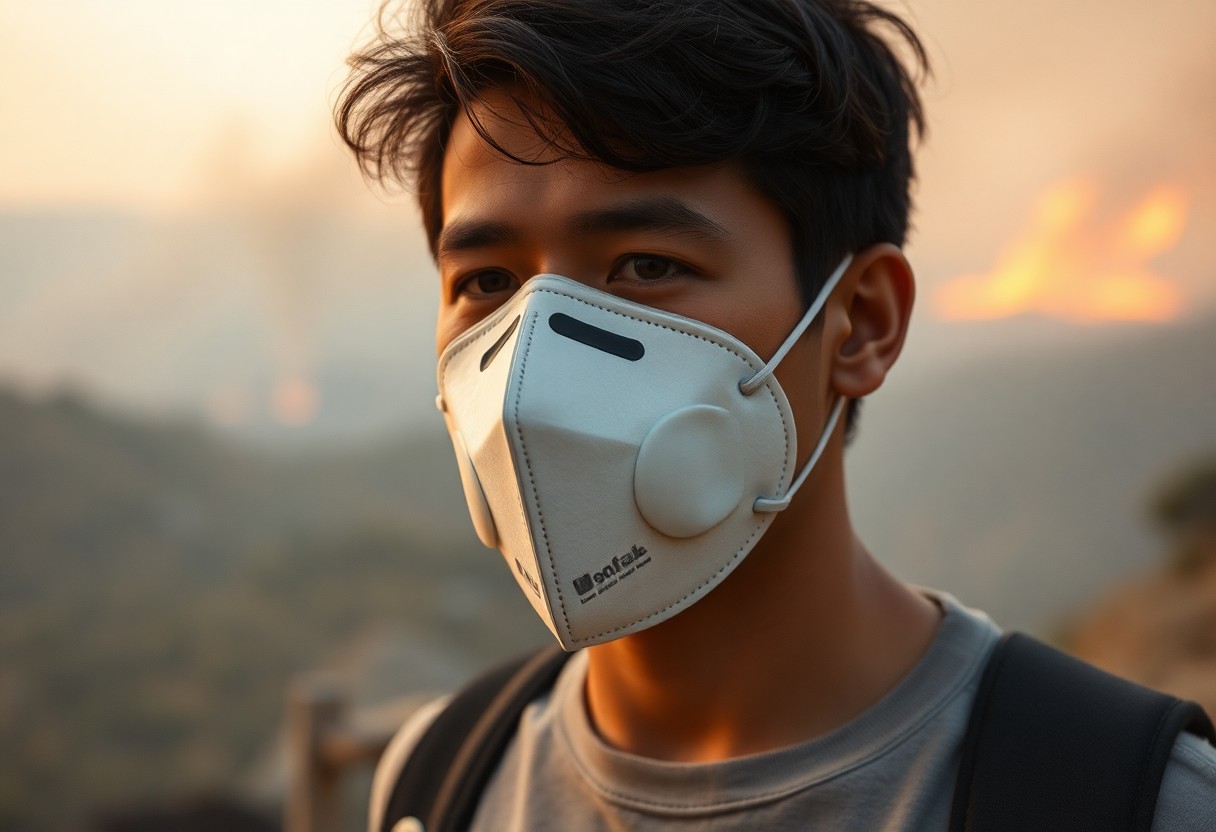Wildfire smoke can significantly impact your health, particularly affecting your lungs. As air quality declines due to nearby fires, it’s vital to take proactive steps to safeguard your respiratory system. Understanding the risks of exposure to wildfire smoke helps you recognize the symptoms to watch for and take action to minimize your risks. This post will provide you with vital information on how to protect yourself when encountering poor air quality, ensuring you breathe easier during these challenging times.
Key Takeaways:
- Wildfire smoke can significantly deteriorate air quality, leading to respiratory issues and other health complications. It’s important to stay informed about local air quality levels during wildfire events.
- To safeguard lung health, limit outdoor activities when air quality is poor, and consider using air purifiers indoors to reduce smoke exposure.
- Wearing masks designed to filter out particulate matter can provide additional protection when going outside is necessary during smoky conditions.

Understanding Wildfire Smoke
Before you venture outdoors during wildfire events, it’s important to understand the nature of wildfire smoke. This smoke is a mixture of gases and fine particles that can travel long distances, affecting air quality far from the fire itself. Wildfire smoke can result from burning vegetation, releasing harmful substances that can compromise your health. Being informed about its sources and behavior can help you better protect yourself and your loved ones during these hazardous conditions.
Composition of Wildfire Smoke
Composition of wildfire smoke is complex, containing a blend of carbon monoxide, volatile organic compounds, and particulate matter, among other pollutants. These microscopic particles can penetrate deep into your lungs, increasing the potential for serious health effects. Understanding its composition is key to recognizing the risks it poses to your respiratory system.
Health Risks Associated with Smoke Inhalation
Above all, inhaling wildfire smoke can lead to various health issues, particularly for individuals with pre-existing respiratory conditions. You may experience irritation of the eyes, throat, and lungs, as well as difficulty breathing and increased risk of infection.
Understanding the health risks associated with smoke inhalation is vital for your well-being. Exposure to wildfire smoke can exacerbate existing conditions such as asthma, chronic obstructive pulmonary disease (COPD), and even contribute to heart problems. Fine particulate matter can penetrate deeply into your lungs, hindering oxygen exchange and leading to serious respiratory issues. If you notice symptoms like coughing, wheezing, or shortness of breath, it’s important to seek shelter and limit your outdoor activities, ensuring you protect your health during wildfire events.
Recognizing Poor Air Quality Indicators
It is vital for you to be aware of various indicators that signal poor air quality. Monitoring these signs can help you protect your health, especially during periods of wildfire smoke. Pay attention to visual cues, like hazy skies, as well as any announcements regarding air quality levels in your area.
Air Quality Index (AQI)
To gauge the safety of your air, regularly check the Air Quality Index (AQI). This numerical scale ranges from 0 to 500, indicating the level of air pollution. An AQI above 100 signals moderate to unhealthy air, which can pose risks to you and your loved ones, especially for individuals with pre-existing respiratory conditions.
Symptoms of Poor Air Quality
By being aware of your body’s reactions to poor air quality, you can take appropriate precautions. Common symptoms include coughing, wheezing, and shortness of breath, which can escalate to more severe issues if ignored.
Symptoms of poor air quality can range from mild to severe and typically affect your respiratory system. Coughing, wheezing, and shortness of breath are common responses to poor air quality, particularly during wildfire events. Furthermore, you may notice irritation in your eyes, nose, or throat, as well as unusual fatigue. If you experience these symptoms, consider reducing outdoor activities and staying indoors with air filtration systems. Long-term exposure without proper precautions can lead to serious health complications, so it’s vital to act quickly.
Protective Measures for Individuals
All individuals must take proactive steps to protect themselves from wildfire smoke exposure. Ensuring that you are well-informed and prepared can significantly reduce the health risks associated with poor air quality. Practicing these protective measures, especially during wildfires, can help safeguard your lungs and overall well-being.
Staying Indoors
Around wildfires, it is imperative to stay indoors as much as possible, particularly during periods of heavy smoke. Keep your windows and doors closed to prevent smoky air from entering your home. Using air purifiers with HEPA filters can improve indoor air quality, providing a safer environment for you and your family.
Use of Masks and Respirators
Protective gear like masks and respirators can be effective in minimizing exposure to harmful smoke particles. Choose N95 or higher-rated masks that fit tightly around your face to filter out fine particulate matter. These masks can provide significant protection when you must venture outdoors, helping to maintain your lung health amidst challenging air quality.
Staying safe during wildfire smoke events requires using appropriate protective equipment. When you wear an N95 mask or a respirator, you block small particles present in the smoke, thus reducing the risk of respiratory issues. Ensure that your mask fits properly to maximize its effectiveness. By taking these precautions, you can actively reduce your risk of exposure and promote better lung health during such adverse conditions.
Preparing Your Home for Wildfire Season
Now is the time to prepare your home for wildfire season by taking proactive steps to reduce the risks associated with smoke and poor air quality. Start by assessing your property and ensuring that it minimizes fire hazards. By cleaning gutters, trimming trees, and having fire-resistant materials, you can protect your home and your lungs from the dangerous effects of wildfire smoke.
Air Filtration Systems
By investing in a high-quality air filtration system, you can significantly improve the air quality inside your home during wildfire season. Look for systems with HEPA filters that can capture fine particles and allergens, helping to keep your indoor environment safe and breathable.
Creating a Smoke-Free Zone
Beside ensuring good ventilation, establishing a designated smoke-free zone within your home can effectively minimize your exposure to harmful wildfire smoke. This space should be as airtight as possible to protect your lungs from hazardous particles that may infiltrate your living area.
A smoke-free zone should ideally be a room with no windows or doors that open to the outside and equipped with an air purifier. Use weather stripping on your doors and windows to create an airtight seal, blocking out as much polluted air as possible. Equip this area with imperative supplies, such as masks, water, and medications, preparing you to ride out hazardous conditions while maintaining your safety and comfort. Your commitment to establishing a smoke-free zone can make a positive difference, protecting you and your loved ones during the wildfire season.
Vulnerable Populations
Not everyone is equally affected by wildfire smoke. Certain groups, such as children, the elderly, and individuals with pre-existing health conditions, are more vulnerable to the harmful effects. For more information, you can refer to Wildfire Smoke and Your Health – MyHealth Alberta, where you can learn about protection strategies tailored to your needs.
Children and the Elderly
Elderly individuals and young children are especially sensitive to poor air quality. Their lungs are not as resilient, increasing the risk of respiratory issues. Ensure you monitor air quality levels and keep these vulnerable groups indoors during smoke events, as it can significantly reduce their risk of health complications.
Individuals with Pre-existing Health Conditions
To protect yourself, stay informed about how wildfire smoke can affect your health if you have pre-existing conditions. These can include respiratory diseases, cardiovascular issues, and asthma, which may be exacerbated by smoke exposure.
Conditions like asthma and chronic obstructive pulmonary disease (COPD) can worsen dramatically when exposed to wildfire smoke. If you have a pre-existing health condition, it’s important to take proactive measures, such as using air purifiers, staying indoors, and having your medications readily available. Consult your healthcare provider for tailored advice and treatment options during high smoke days to ensure your health remains a priority.
Community Actions and Resources
Despite the challenges posed by wildfire smoke, you can take proactive steps with your community to enhance safety. Engaging with local organizations and participating in community programs can provide vital support and resources during times of poor air quality. Making connections with your neighbors and sharing information can foster a sense of unity and resilience while effectively protecting your lungs and health.
Local Alerts and Warnings
Alerts about air quality and wildfire risks are crucial for your safety. Stay informed by monitoring local weather stations, and public health announcements, and utilizing mobile apps that provide real-time updates. Being aware of hazardous conditions will empower you to take necessary precautions to protect your health.
Community Support Services
Beside staying informed, many communities offer support services during wildfire events. Reach out to local health departments, social services, and volunteer organizations that provide assistance to individuals affected by poor air quality. They can offer resources like air filters, emergency shelters, and health check-ups aimed at safeguarding your well-being.
Understanding the range of community support services available is key to ensuring your safety during wildfire smoke events. These services often include access to air filtration devices, emergency shelters, and health screenings to help you monitor respiratory conditions. Additionally, local organizations may provide transportation assistance for those needing to evacuate or seek medical attention. By leveraging these resources, you strengthen your defense against the health risks posed by wildfire smoke.
Summing up
Following this guidance, you can take proactive steps to protect your lungs during periods of poor air quality caused by wildfire smoke. Staying informed about air quality levels, reducing outdoor activities, and using masks when necessary are vital actions you can implement. Your health and well-being depend on your response to these conditions, so prioritize your respiratory safety by following these practical recommendations. By doing so, you are better equipped to navigate through these challenging times while safeguarding your health.
FAQ
Q: What are the health risks associated with wildfire smoke?
A: Wildfire smoke contains a mixture of gases and fine particles that can pose significant health risks, particularly to the respiratory system. Exposure may lead to symptoms such as coughing, throat irritation, eye irritation, and exacerbation of pre-existing respiratory conditions like asthma and chronic obstructive pulmonary disease (COPD). Long-term exposure can increase the risk of respiratory infections and other serious health issues. Vulnerable populations, including children, the elderly, and individuals with pre-existing health conditions, are especially at risk.
Q: How can I minimize my exposure to wildfire smoke?
A: To reduce exposure to wildfire smoke, consider staying indoors during periods of elevated smoke levels. Use air purifiers with HEPA filters to improve indoor air quality, and keep windows and doors closed. If available, air conditioning can help circulate clean air. Avoid outdoor activities that require heavy exertion, as increased physical activity can lead to deeper inhalation of smoke particles. If you must go outside, wearing an N95 respirator can help filter out harmful particles from the air.
Q: What should I do if I experience symptoms from wildfire smoke exposure?
A: If you experience symptoms such as difficulty breathing, persistent cough, or chest pain after being exposed to wildfire smoke, it’s important to seek medical assistance. Healthcare professionals can provide guidance and treatment based on the severity of your symptoms. It’s also advisable to follow up with any known health conditions you have, and keep your healthcare provider informed about your exposure to smoke. Make sure to stay hydrated and rest to support your body’s recovery.

Leave a Reply